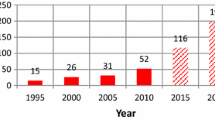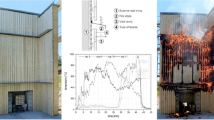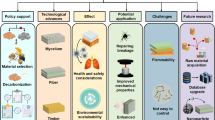Abstract
The paper formulates some fundamental principles of performance-based design (PBD), suggesting a conceptual framework and systematic approach suitable for application in most areas of building design, and in the development of simulation tools and performance test methods required in the design and assessment processes. A schematic algorithm, which has been developed for the common engineering approach, was helpful in identifying the inter-relation with the required knowledge-based databases and tools that are needed for proper implementation of PBD. It is also shown that this schematic algorithm can serve not only as a conceptual model but also as the basic framework for developing or adapting simulation tools that are intended for PBD and assessment. The last part of the paper demonstrates the application of the fundamental approach in several areas of building performance (fire safety, acoustics, moisture safety, indoor air quality, and durability), outlining in each area the main user needs, ensuing performance requirements, and the most significant capabilities required of adequate simulation tools, with an emphasis on input/output.
Similar content being viewed by others
References
Aouad G, Lee A, Wu S (2005). nD modelling for collaborative working in construction. Architectural Engineering and Design Management, 1(1): 33–44.
ASHRAE (2007). ANSI/ASHRAE 62.1-2007-Ventilation for Acceptable Indoor Air Quality. Atlanta, GA: American Society of Heating, Refrigerating and Air-Conditioning Engineers.
ASTM/CIB/RILEM (1982). Proceedings of the ASTM/CIB/RILEM Symposium on Performance Concept in Building. Lisbon, Portugal: LNEC-National Laboratory for Civil Engineering.
ASTM (2005). ASTM E2351-Standard Guide for Specifying and Evaluating Performance of Single Family Attached and Detached Dwellings-Functionality. ASTM International.
Becker R, Paciuk M (eds) (1996). Proceedings of the 3rd International Symposium on Applications of the Performance Concept in Building. Haifa, Israel: National Building Research Institute, Technion-Israel Institute of Technology.
Becker R (2001). An integrated approach to the development of performance test methods and their application to evaluation and design. RILEM Journal Materials and Structures, 2001(34): 467–474.
Becker R, Foliente G (2005). Performance Based International State of the Art-PeBBu 2nd International SotA Report. Rotterdam, the Netherlands: CIBdf-International Council for Research and Innovation in Building and Construction-Development Foundation.
Blachere G (1965). General consideration of standards, agrement and the assessment of fitness for use. Paper presented at the 3rd CIB Congress on Towards Industrialised Building, held in Copenhagen, Denmark.
Blachere G (1987). Building Principles. Commission of the European Communities, Industrial Processes, Building and Civil Engineering. Directorate-General, Internal Market and Industrial Affairs. EUR 11320 EN.
Bozorgnia Y, Bertero VV (2004). Earthquake Engineering: From Engineering Seismology to Performance-Based Engineering. Boca Raton, Florida: ICC-CRC Press.
CEN (2002). EN 12152:2002 Curtain Walling-Air Permeability-Performance Requirements and Classification. CEN, European Commission for Standardization, Brussels.
CEN (2002)-2007). Structural Eurocodes (EN 1990-Eurocode: Basis of structural design. EN 1991-Eurocode 1: Actions on structures. EN 1992-Eurocode 2: Design of concrete structures. EN 1993-Eurocode 3: Design of steel structures. EN 1994-Eurocode 4: Design of composite steel and concrete structures. EN 1995-Eurocode 5: Design of timber structures. EN 1996-Eurocode 6: Design of masonry structures. EN 1997-Eurocode 7: Geotechnical design. EN 1998-Eurocode 8: Design of structures for earthquake resistance. EN 1999-Eurocode 9: Design of aluminium structures). CEN, European Commission for Standardization, Brussels.
CEN (2004). EN 13779:2004-Ventilation for Non-residential Buildings-Performance Requirements for Ventilation and Room-Conditioning Systems. CEN, European committee for standardization, Brussels.
CIB (2001). Proceedings of the CIB world building congress: Performance in product and practice. Rotterdam, the Netherlands: CIBdf-International Council for Research and Innovation in Building and Construction-Development Foundation.
CSTB (1988). Proceedings of the international conference on performance requirements in building. Paris, France: CSTB-Centre Scientific at Technique du Batiment.
CSTB publications. Agrement and Avis Technique documents. Paris, France: CSTB-Centre Scientific at Technique du Batiment.
Davis G, Ventre F (eds) (1990). Performance of buildings and serviceability of facilities. Publication STP 1029-EB. ASTM International.
DOE (2005)a. Building energy codes program. Available via US Department of Energy. http://www.energycodes.gov/
DOE (2005)b. US Department of Energy-Energy efficiency and renewable energy, building technologies program and software tools web site, EnergyPlus page: http://www.eere.energy.gov/buildings/energy_tools/energyplus/
European Commission (1989). CPD-The construction products directive (Council Directive 89/106/EEC). Available via New Approach. Office for official publication of the European Communities. http://eurlex.europa.eu/LexUriServ/LexUriServ.do?uri=CELEX:31989L0106:EN:NOT
European Commission (2000). Guide to the implementation of directives based on the New Approach and the Global Approach. Office for official publication of the European Communities. http://ec.europa.eu/enterprise/newapproach/index_en.htm
Fenn P, Haugbølle K, Morse T (2005). Final report on legal and procurement practices (Domain 6). PeBBu Network. Rotterdam, the Netherlands: CIBdf-International Council for Research and Innovation in Building and Construction.
Foster BE (1972). Proceedings of the 1st International RILEMASTM-CIB Symposium on the Performance Concept in Building. NBS Special Publication 361, Vol 1 & 2. Washington DC, USA: US Government Printing Office.
Franssen JM (2003). SAFIR. A thermal/structural program modelling structures under fire. In: Proceedings NASCC, April 2003, AISC Inc., Baltimore, USA.
Gibson EJ (1982). Working with the performance approach in building. Report of Working Commission W060, CIB Publication 64. Rotterdam, the Netherlands: CIBdf-International Council for Research and Innovation in Building and Construction-Development Foundation.
Hattis DB, Becker R (2001). The systems approach and the nordic model-A comparison and melded application to performancebased building codes and standards. ASTM Journal of Testing and Evaluation, JTEVA, 29(4): 413–422.
Huovila P (2005). Performance based building-Proceedings of the international symposium on combining forces-Advancing facilities management and construction through innovation. Rotterdam, the Netherlands: CIBdf-International Council for Research and Innovation in Building and Construction-Development Foundation.
ICC (2006). ICC performance code for buildings and facilities. Washington DC USA: International Code Council.
ISO (1980). ISO 6240-Performance standards in building-Contents and presentation. ISO-International Organisation for Standardisation.
ISO (1984). ISO 6241-Performance standards in building-Principles for their preparation and factors to be considered. ISO-International Organisation for Standardisation.
ISO (1992). ISO 6242-Building construction-Expression of users’ requirements-Part 1: Thermal requirements, Part 2: Air purity requirements, Part 3: Acoustical requirements. ISO-International Organisation for Standardisation.
Jaegermann C, Becker R, Blujger E, Brand H, Hoffman M, Neeman E, Kellr J, Rozenblith I, Rektor J (1978). Performance specifications for building elements for single and multifamily housing up to 4 storeys. Report 019-003. Haifa, Israel: Building Research Station, Technion-Israel Institute of Technology.
NBS (1970). Guide criteria for the design and evaluation of operation breakthrough housing systems. NBS Report 10200. Washington DC, USA: US Department of Commerce, National Bureau of Standards.
Rosenbaum ER (2005). SFPE Engineering Guide to Performance-Based Fire Protection Analysis and Design of Buildings. Draft 2nd edition. USA: SFPE-Society of Fire Protection Engineers.
Ruck NC (1989). Building Design and Human Performance. NY USA: Van Nostrand Reinhold.
SFPE (2004). The SFPE Code Official’s Guide to Performance-Based Design Review. USA: SFPE-Society of Fire Protection Engineers.
Soulages J (1995). Performance Based Seismic Engineering of Buildings. Sacramento, CA. USA: Structural Engineers Assn. of California-SEAOC, Vision 2000 Committee. 2 vols.
Spekkink D (2005). Final report on performance based design of buildings (Domain 3). PeBBu Network. Rotterdam, the Netherlands: CIBdf-International Council for Research and Innovation in Building and Construction.
Vitruvius (1 B.C.). The Ten Books on Architecture. Translated: Morris Hicky Morgan. NY, USA (1960): Dover publications, Inc.
Author information
Authors and Affiliations
Corresponding author
Rights and permissions
About this article
Cite this article
Becker, R. Fundamentals of performance-based building design. Build. Simul. 1, 356–371 (2008). https://doi.org/10.1007/s12273-008-8527-8
Received:
Revised:
Accepted:
Published:
Issue Date:
DOI: https://doi.org/10.1007/s12273-008-8527-8




